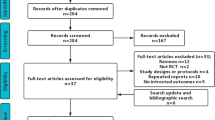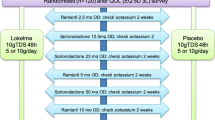Abstract
Background
Hyperkalemia leads to suboptimal use of evidence-based therapies in patients with heart failure (HF). Therefore, we aimed to assess whether new potassium binders are effective and safe to promote medical optimization in patients with HF.
Methods
MEDLINE, Cochrane, and Embase were searched for randomized controlled trials (RCTs) that reported outcomes after initiation of Patiromer or Sodium Zirconium Cyclosilicate (SZC) versus placebo in patients with HF at high risk of hyperkalemia development. Risk ratios (RR) with 95% confidence intervals (CI) were pooled with a random effects model. Quality assessment and risk of bias were performed according to Cochrane recommendations.
Results
A total of 1432 patients from 6 RCTs were included, of whom 737 (51.5%) patients received potassium binders. In patients with HF, potassium binders increased the use of renin–angiotensin–aldosterone inhibitors (RR 1.14; 95% CI 1.02–1.28; p = 0.021; I2 = 44%) and reduced the risk of hyperkalemia (RR 0.66; 95% CI 0.52–0.84; p < 0.001; I2 = 46%). The risk of hypokalemia was significantly increased in patients treated with potassium binders (RR 5.61; 95% CI 1.49–21.08; p = 0.011; I2 = 0%). There was no difference between groups in all-cause mortality rates (RR 1.13; 95% CI 0.59–2.16; p = 0.721; I2 = 0%) or in adverse events leading to drug discontinuation (RR 1.08; 95% CI 0.60–1.93; p = 0.801; I2 = 0%).
Conclusion
The use of new potassium binders Patiromer or SZC in patients with HF at risk for hyperkalemia increased the rates of medical therapy optimization with renin–angiotensin–aldosterone inhibitors and reduced the incidence of hyperkalemia, at the cost of an increased prevalence of hypokalemia.
Graphical abstract




Similar content being viewed by others
Data availability
The data underlying this article are available in the article and in Supplementary material online.
Abbreviations
- ACEi:
-
Angiotensin-Converting Enzyme inhibitors
- ARB:
-
Angiotensin Receptor Blockers
- ARNI:
-
Angiotensin receptor-neprilysin inhibitors
- CI:
-
Confidence interval
- CKD:
-
Chronic kidney disease
- Em:
-
Resting membrane potential
- eGFR:
-
Estimated glomerular filtration rate (eGFR)
- HF:
-
Heart failure
- LVEF:
-
Left ventricular ejection fraction
- MRA:
-
Mineralocorticoid receptor antagonist
- OR:
-
Odds ratio
- PRISMA:
-
Preferred Reporting Items for Systematic Reviews and Meta-Analysis
- RAASi:
-
Renin–Angiotensin–Aldosterone System inhibitors
- RCT:
-
Randomized controlled trials
- RoB2:
-
Cochrane tool for assessing risk of bias in randomized trials
- SZC:
-
Sodium Zirconium Cyclosilicate
References
Pitt B, Zannad F, Remme WJ et al (1999) The effect of spironolactone on morbidity and mortality in patients with severe heart failure. Randomized Aldactone Evaluation Study Investigators. N Engl J Med. 341(10):709–717. https://doi.org/10.1056/NEJM199909023411001
Ay J, Ohn NC, Ianni G et al (2001) A randomized trial of the angiotensin-receptor blocker valsartan in chronic heart failure. N Engl J Med 345(23):1667–1675. https://doi.org/10.1056/NEJMOA010713
Effects of enalapril on mortality in severe congestive heart failure. Results of the Cooperative North Scandinavian Enalapril Survival Study (CONSENSUS). N Engl J Med. 1987;316(23):1429–1435. doi:https://doi.org/10.1056/NEJM198706043162301
McMurray JJV, Packer M, Desai AS et al (2014) Angiotensin-neprilysin inhibition versus enalapril in heart failure. N Engl J Med. 371(11):132–133. https://doi.org/10.1056/NEJMOA1409077
Heidenreich PA, Bozkurt B, Aguilar D et al (2022) 2022 AHA/ACC/HFSA Guideline for the Management of Heart Failure: a Report of the American College of Cardiology/American Heart Association Joint Committee on Clinical Practice Guidelines. Circulation 145(18):E895–E1032. https://doi.org/10.1161/CIR.0000000000001063
McDonagh TA, Metra M, Adamo M et al (2021) 2021 ESC Guidelines for the diagnosis and treatment of acute and chronic heart failure. Eur Heart J 42(36):3599–3726. https://doi.org/10.1093/EURHEARTJ/EHAB368
Raebel MA (2012) Hyperkalemia associated with use of angiotensin-converting enzyme inhibitors and angiotensin receptor blockers. Cardiovasc Ther 30(3):e156–e166. https://doi.org/10.1111/J.1755-5922.2010.00258.X
Ingelfinger JR (2015) A new era for the treatment of hyperkalemia? N Engl J Med 372(3):275–277. https://doi.org/10.1056/NEJME1414112/SUPPL_FILE/NEJME1414112_DISCLOSURES.PDF
Weiss JN, Qu Z, Shivkumar K (2017) Electrophysiology of hypokalemia and hyperkalemia. Circ Arrhythm Electrophysiol. https://doi.org/10.1161/CIRCEP.116.004667
Linder KE, Krawczynski MA, Laskey D (2016) Sodium zirconium cyclosilicate (ZS-9): a novel agent for the treatment of hyperkalemia. Pharmacotherapy 36(8):923–933. https://doi.org/10.1002/PHAR.1797
Colbert GB, Patel D, Lerma EV (2020) Patiromer for the treatment of hyperkalemia. Expert Rev Clin Pharmacol. 13(6):563–570. https://doi.org/10.1080/17512433.2020.1774363
Kim K, Fagerström J, Chen G, Lagunova Z, Furuland H, McEwan P (2022) Cost effectiveness of sodium zirconium cyclosilicate for the treatment of hyperkalaemia in patients with CKD in Norway and Sweden. BMC Nephrol 23(1):1–11. https://doi.org/10.1186/S12882-022-02903-7
Montagnani A, Frasson S, Gussoni G, Manfellotto D (2021) Optimization of RAASi therapy with new potassium binders for patients with heart failure and hyperkalemia: rapid review and meta-analysis. J Clin Med. https://doi.org/10.3390/JCM10235483
Page MJ, McKenzie JE, Bossuyt PM et al (2021) The PRISMA 2020 statement: an updated guideline for reporting systematic reviews. BMJ. https://doi.org/10.1136/BMJ.N71
Sterne JAC, Savović J, Page MJ et al (2019) RoB 2: a revised tool for assessing risk of bias in randomised trials. BMJ. https://doi.org/10.1136/BMJ.L4898
Rossignol P, Williams B, Mayo MR et al (2020) Patiromer versus placebo to enable spironolactone use in patients with resistant hypertension and chronic kidney disease (AMBER): results in the pre-specified subgroup with heart failure. Eur J Heart Fail 22(8):1462–1471. https://doi.org/10.1002/ejhf.1860
Butler J, Anker SD, Lund LH et al (2022) Patiromer for the management of hyperkalemia in heart failure with reduced ejection fraction: the DIAMOND trial. Eur Heart J. https://doi.org/10.1093/eurheartj/ehac401. ((Butler J.; Siddiqi T.J.) Department of Medicine, University of Mississippi, Jackson, MS, United States)
Anker SD, Kosiborod M, Zannad F et al (2015) Maintenance of serum potassium with sodium zirconium cyclosilicate (ZS-9) in heart failure patients: Results from a phase 3 randomized, double-blind, placebo-controlled trial. Eur J Heart Fail 17(10):1050–1056. https://doi.org/10.1002/ejhf.300
Pitt B, Bakris GL, Bushinsky DA et al (2015) Effect of patiromer on reducing serum potassium and preventing recurrent hyperkalaemia in patients with heart failure and chronic kidney disease on RAAS inhibitors. Eur J Heart Fail 17(10):1057–1065. https://doi.org/10.1002/ejhf.402
Pitt B, Anker SD, Bushinsky DA, Kitzman DW, Zannad F, Huang IZ (2011) Evaluation of the efficacy and safety of RLY5016, a polymeric potassium binder, in a double-blind, placebo-controlled study in patients with chronic heart failure (the PEARL-HF) trial. Eur Heart J 32(7):820–828. https://doi.org/10.1093/eurheartj/ehq502
Potassium Reduction Initiative to Optimize RAAS Inhibition Therapy With Sodium Zirconium Cyclosilicate in Heart Failure—Study Results—ClinicalTrials.gov. https://clinicaltrials.gov/ct2/show/results/NCT03532009?term=prioritize+hf&draw=2&rank=1&view=results. Accessed 10 Aug 2022
Tardif JC, Rouleau J, Chertow GM et al (2022) Potassium reduction with sodium zirconium cyclosilicate in patients with heart failure. ESC Heart Fail. https://doi.org/10.1002/EHF2.14268
Li L, Harrison SD, Cope MJ et al (2016) Mechanism of action and pharmacology of patiromer, a nonabsorbed cross-linked polymer that lowers serum potassium concentration in patients with hyperkalemia. J Cardiovasc Pharmacol Ther 21(5):456–465. https://doi.org/10.1177/1074248416629549
Murphy D, Banerjee D (2022) Hyperkalaemia in heart failure: consequences for outcome and sequencing of therapy. Curr Heart Fail Rep 19(4):191. https://doi.org/10.1007/S11897-022-00552-3
Campese VM, Adenuga G (2016) Electrophysiological and clinical consequences of hyperkalemia. Kidney Int Suppl (2011). 6(1):16–19. https://doi.org/10.1016/J.KISU.2016.01.003
Ferreira JP, Butler J, Rossignol P et al (2020) Abnormalities of potassium in heart failure: JACC state-of-the-art review. J Am Coll Cardiol 75(22):2836–2850. https://doi.org/10.1016/J.JACC.2020.04.021
Desai AS, Liu J, Pfeffer MA et al (2018) Incident hyperkalemia, hypokalemia, and clinical outcomes during spironolactone treatment of heart failure with preserved ejection fraction: analysis of the TOPCAT trial. J Card Fail 24(5):313–320. https://doi.org/10.1016/J.CARDFAIL.2018.03.002
Lund LH, Pitt B (2018) Is hyperkalaemia in heart failure a risk factor or a risk marker? Implications for renin-angiotensin-aldosterone system inhibitor use. Eur J Heart Fail 20(5):931–932. https://doi.org/10.1002/EJHF.1175
Beusekamp JC, Tromp J, van der Wal HH et al (2018) Potassium and the use of renin-angiotensin-aldosterone system inhibitors in heart failure with reduced ejection fraction: data from BIOSTAT-CHF. Eur J Heart Fail 20(5):923–930. https://doi.org/10.1002/EJHF.1079
Chang AR, Sang Y, Leddy J et al (2016) Antihypertensive medications and the prevalence of hyperkalemia in a large health system. Hypertension 67(6):1181–1188. https://doi.org/10.1161/HYPERTENSIONAHA.116.07363
Ben Salem C, Badreddine A, Fathallah N, Slim R, Hmouda H (2014) Drug-induced hyperkalemia. Drug Saf 37(9):677–692. https://doi.org/10.1007/S40264-014-0196-1
Aldahl M, Caroline Jensen AS, Davidsen L et al (2017) Associations of serum potassium levels with mortality in chronic heart failure patients. Eur Heart J 38(38):2890–2896. https://doi.org/10.1093/EURHEARTJ/EHX460
Linde C, Qin L, Bakhai A et al (2019) Serum potassium and clinical outcomes in heart failure patients: results of risk calculations in 21 334 patients in the UK. ESC Heart Fail 6(2):280–290. https://doi.org/10.1002/EHF2.12402
Cooper LB, Benson L, Mentz RJ et al (2020) Association between potassium level and outcomes in heart failure with reduced ejection fraction: a cohort study from the Swedish Heart Failure Registry. Eur J Heart Fail 22(8):1390–1398. https://doi.org/10.1002/EJHF.1757
Tannen RL (1985) Diuretic-induced hypokalemia. Kidney Int 28(6):988–1000. https://doi.org/10.1038/KI.1985.229
Rossignol P, Girerd N, Bakris G et al (2017) Impact of eplerenone on cardiovascular outcomes in heart failure patients with hypokalaemia. Eur J Heart Fail 19(6):792–799. https://doi.org/10.1002/EJHF.688
Cooper LB, Hammill BG, Peterson ED et al (2015) Consistency of laboratory monitoring during initiation of mineralocorticoid receptor antagonist therapy in patients with heart failure. JAMA 314(18):1973. https://doi.org/10.1001/JAMA.2015.11904
Funding
This study received no funding.
Author information
Authors and Affiliations
Contributions
PC and TV conceived and designed the study. PC, TV, and DM independently assessed the studies for possible inclusion and collected the data. PC, HO, and MT analyzed the data. PC and DM produced the first draft of the manuscript. MCPN and ACSS made general supervision and were responsible for data interpretation and writing the final version. All authors approved the final version of the manuscript.
Corresponding author
Ethics declarations
Conflict of interest
All authors report no relationships that could be construed as a conflict of interest. All authors take responsibility for all aspects of the reliability and freedom from bias of the data presented and their discussed interpretation.
Supplementary Information
Below is the link to the electronic supplementary material.
Rights and permissions
Springer Nature or its licensor (e.g. a society or other partner) holds exclusive rights to this article under a publishing agreement with the author(s) or other rightsholder(s); author self-archiving of the accepted manuscript version of this article is solely governed by the terms of such publishing agreement and applicable law.
About this article
Cite this article
Carvalho, P.E.P., Veiga, T.M.A., Lacerda, H. et al. Safety and efficacy of new potassium binders on hyperkalemia management in patients with heart failure: a systematic review and meta-analysis of randomized controlled trials. Clin Res Cardiol 112, 991–1002 (2023). https://doi.org/10.1007/s00392-023-02215-2
Received:
Accepted:
Published:
Issue Date:
DOI: https://doi.org/10.1007/s00392-023-02215-2




